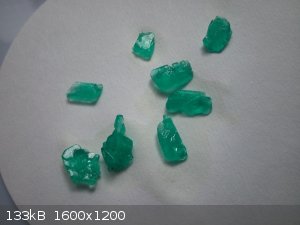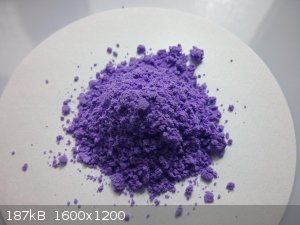Neuro-
Harmless

Posts: 29
Registered: 24-1-2016
Member Is Offline
Mood: No Mood
|
|
Cleaning Sodium Copper Dichloroisocyanurate
Hello, I was wondering, as I just made the aforementioned compound from copper sulfate and sodium dichloroisocyanurate from bleach crystals if there
is a way to clean the basic copper carbonate out that I believe appeared as the result of me neglecting to acidify the solution. Although I understand
that it is unlikely that there are no experts on the compound (Na2[Cu(C3N3O3Cl2)4]), would there be anything I could do that could selectively make
the copper carbonate soluble?
|
|
|
Chemist_Cup_Noodles
Harmless

Posts: 46
Registered: 27-5-2015
Location: Northern VA
Member Is Offline
Mood: Anticipative
|
|
Alright so I wouldn't call myself an expert on the compound, but I've done a little reading and digging on your product here, and I've found a very
relevant patent regarding the very type of complex you've formed. So I guess I'm reading from the inventor of it, who I'd say is an expert. It says in the
patent that the solution must be kept acidic during production in order to keep the hydroxides from forming. Are you sure it is basic copper
carbonate? I would say you should try taking a sample of it and heating it to about 290oC to test whether it is basic copper carbonate or
cupric hydroxide because at this temperature, basic copper carbonate will decompose. If you see example 6 from the patent, he heats his product to
about 250oC in order to see how much mass was lost, and it holds up quite well. So maybe take a sample of your precipitate, heat it to or a
little above 290, and mass it afterwards. If it loses a lot of mass and changes to mostly blackish in color, it is the carbonate. If it loses only
some mass and retains the majority of it's color, it should be the hydroxide.
Maybe you could clean it though by slowly adding medium strength hydrochloric acid to react with, neutralize, and dissolve the basic copper carbonate
(or hydroxide). I'd say to add it a few mL at a time, stirring the solution in between additions and measuring the pH frequently.
On a related note, I don't know if you've got a very good yield because complex ions tend to form much better in acidic solutions. So you might want
to try doing another reaction starting under slightly acidic conditions, and maybe use a solvent such as acetone as the inventor did.
But you mentioned that you are using bleach crystals. What specifically do you mean by this? Do you mean liquid bleach, or a dry form of pool/
drinking water sanitizer? Because I've seen a lot of various chlorinated isocyanurate pool care products that might be a good point to start from.
This is a very very interesting compound though. Could you post pictures of it if you get a good product? I'd love to see the color.
I'll be honest-- We're throwing science at the wall here to see what sticks. No idea what it'll do.
-Cave Johnson, Portal 2
Add yourself to this map of SciMad members! https://zeemaps.com/map?group=388676&add=1
|
|
|
spot
Harmless

Posts: 4
Registered: 12-9-2016
Location: Cornwall
Member Is Offline
Mood: No Mood
|
|
I like the colour name given in the patent: "The color of the precipitate was Periwinkle". Not a colour I'd heard of. Lilac or Purple, yes.
The patent also mentions a complex with nickel and with cadmium. I don't have any cadmium salts on my shelf but I do have nickel chloride, and that
gives a pale green crystal in contrast with copper's periwinkle powder. The photo is on 9cm filter paper, to get an idea of scale.
Neither dissolves much in water or in acetone. If anyone has a solvent suggestion I'll try recrystallizing the products.
I have cadmium bar which ought to dissolve in some strength of hydrogen chloride, in which case I'll try that too.
eta: The more I look at that photo on the left the more I reckon that's nickel hydroxide crystals. I'll have another shot at that one and check the
pH. And I'll try dissolving a crystal in dilute HCl too.
 
[Edited on 16-9-2016 by spot]
|
|
|
mayko
International Hazard
    
Posts: 1218
Registered: 17-1-2013
Location: Carrboro, NC
Member Is Offline
Mood: anomalous (Euclid class)
|
|
HCl will react with the DCCA, forming chlorine. I'd probably use dilute sulfuric or maybe acetic if I was going to try to redissolve the
hydroxide/basic carbonate.
al-khemie is not a terrorist organization
"Chemicals, chemicals... I need chemicals!" - George Hayduke
"Wubbalubba dub-dub!" - Rick Sanchez
|
|
|